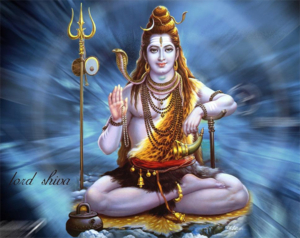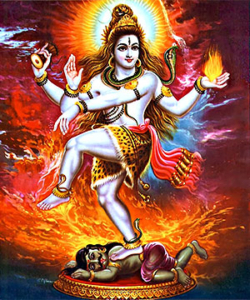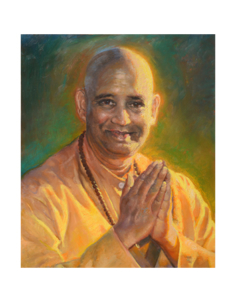The Mysticism of Lord Shiva
 by Swami Jyotirmayananda
by Swami Jyotirmayananda
Lord Shiva is the Absolute Self presented in a personified form. As with all forms of Divinity revealed by Sages, Shiva’s form is a highly mystic and poetic portrayal of the Absolute Self. His head is covered with matted locks, representing the mysteries of spiritual life. They also denote the Himalayan Mountains, which symbolically represent the sublime spiritual thoughts arising out of profound meditation.
The Ganges River flows from Lord Shiva’s Head, representing the stream of Divine wisdom. On His Forehead is a crescent moon, symbolizing mastery over the mind. For most people, the mind continually sways between the pairs of opposites, ever waxing and waning; but for Lord Shiva, the crescent shape is perpetually present, eternally under his control.
The snakes on Shiva’s body represent Kundalini Shakti, the primal energy latent within each individual. The ashes that cover his body are a reminder of the mighty fire of wisdom that destroys the world-process.
Finally, the mystical stories of the Puranas describe Lord Shiva with a third eye. Although normally closed, this eye is opened during Shiva’s dissolution of negative forces. Shiva’s third eye is symbolic of intuitive vision, which destroys ignorance – the source of desire for ephemeralities and the cause of the world-process. It is for this reason that many artists portray Lord Shiva as a ghostly being decked with ashes, attended by goblins and skeletons. As the embodiment of Param Jnana (Absolute Wisdom) and Sanyasa (renunciation), Lord Shiva pays no importance to externalities – his piercing intuition strips the world-process of names and forms, leaving the non-dual Reality of Absolute Existence, Absolute Knowledge, and Absolute Bliss.
Shivaratri literally means “the Night of Shiva,” the night dedicated to the devotional worship of Lord Shiva, and the night of the mystical marriage of Shiva to Uma, or Parvati. On Shivaratri people observe certain disciplines including the practice of fasting. The purpose of this “fastivity” is to starve that aspect of your personality that runs after the objects of the world for happiness, while encouraging your heart and mind to move towards God.
Brahman is the term in the Upanishads for the Absolute Self. Although that Self is One, Brahman in the realm of Maya (Cosmic Illusion) is like an actor who plays three roles: the first is Brahma the Creator, the second is Vishnu the Sustainer, and the third is Shiva the Destroyer.
 The process of destruction is like a grand Cosmic Dance. Lord Shiva is ever dancing, and this dance is reflected in the pulsation of your heart, in the movement of the planets circling the sun again and again, in the rising and the setting of the sun, and in the beat, music, and dance of the tides. Shiva’s Cosmic Dance is the rhythm, vibration, pulsation, and timing sustained by all creatures and all beings.
The process of destruction is like a grand Cosmic Dance. Lord Shiva is ever dancing, and this dance is reflected in the pulsation of your heart, in the movement of the planets circling the sun again and again, in the rising and the setting of the sun, and in the beat, music, and dance of the tides. Shiva’s Cosmic Dance is the rhythm, vibration, pulsation, and timing sustained by all creatures and all beings.
In this dance, things that were old are destroyed and new things arise. Unless there is destruction, nothing new can develop. Thus, demolition and new construction are companions. A seed must destroy itself in order to sprout. As a candle burns there is constant destruction, yet light emanates from the burning of the flame.
The basis of all karmas, which are the cause of repeated embodiments, is ignorance. When ignorance is destroyed, the Jiva, the soul within you, unites with Shiva, the Absolute Self. Sanyasis (renunciates) adore Lord Shiva as the Supreme Deity because the goal of one who has developed the spirit of renunciation is to become free of all karma through the cessation of the world process. It is Shiva within who brings this about. It is His Dance that destroys the illusions and impurities of the mind, thus paving the way to enlightenment.
May Lord Shiva lead you to the glorious heights of Truth – Satyam, and free you of all bondage.


